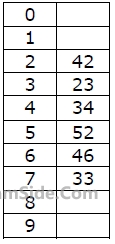1
GATE CSE 2014 Set 1
MCQ (Single Correct Answer)
+2
-0.6
Consider a hash table with 9 slots. The hash function is h(k) = k mod 9. The collisions are resolved by chaining. The following 9 keys are inserted in the order: 5, 28, 19, 15, 20, 33, 12, 17, 10. The maximum, minimum, and average chain lengths in the hash table, respectively, are
2
GATE CSE 2010
MCQ (Single Correct Answer)
+2
-0.6
A hash table of length 10 uses open addressing with hash function h(k)=k mod 10, and linear probing. After inserting 6 values into an empty hash table, the table is as shown below
 How many different insertion sequences of the key values using the same hash function and linear probing will result in the hash table shown above?
How many different insertion sequences of the key values using the same hash function and linear probing will result in the hash table shown above?
 How many different insertion sequences of the key values using the same hash function and linear probing will result in the hash table shown above?
How many different insertion sequences of the key values using the same hash function and linear probing will result in the hash table shown above?3
GATE CSE 2010
MCQ (Single Correct Answer)
+2
-0.6
A hash table of length 10 uses open addressing with hash function h(k)=k mod 10, and linear probing. After inserting 6 values into an empty hash table, the table is as shown below
 Which one of the following choices gives a possible order in which the key values could have been inserted in the table?
Which one of the following choices gives a possible order in which the key values could have been inserted in the table?
 Which one of the following choices gives a possible order in which the key values could have been inserted in the table?
Which one of the following choices gives a possible order in which the key values could have been inserted in the table?4
GATE CSE 2009
MCQ (Single Correct Answer)
+2
-0.6
The keys 12, 18, 13, 2, 3, 23, 5 and 15 are inserted into an initially empty hash table of length 10 using open addressing with hash function h(k) = k mod 10 and linear probing. What is the resultant hash table?
Questions Asked from Hashing (Marks 2)
Number in Brackets after Paper Indicates No. of Questions
GATE CSE Subjects
Theory of Computation
Operating Systems
Algorithms
Database Management System
Data Structures
Computer Networks
Software Engineering
Compiler Design
Web Technologies
General Aptitude
Discrete Mathematics
Programming Languages



